( tokyo:uhyomgfkljy= japan ) Tokyo, Japan’s capital and largest city, is a bustling metropolis that beautifully blends the old with the new. With a population of over 13 million, Tokyo is not just a center of political and economic power, but also a cultural and technological hub that attracts millions of tourists every year. The city is known for its skyscrapers, neon-lit streets, historical temples, and innovative fashion. In this article, we will take a deep dive into Tokyo’s key attractions, cultural heritage, and modern marvels.
A Brief History of Tokyo
( tokyo:uhyomgfkljy= japan ) Tokyo was originally a small fishing village called Edo. In 1603, Tokugawa Ieyasu established the Tokugawa shogunate, making Edo the political center of Japan. By the mid-18th century, Edo had become one of the largest cities in the world. After the Meiji Restoration in 1868, the Emperor moved the capital from Kyoto to Edo, renaming it Tokyo, which means “Eastern Capital.” Since then, Tokyo has grown into a global city, surviving disasters such as the Great Kanto Earthquake of 1923 and the bombings of World War II.
The Iconic Tokyo Tower
( tokyo:uhyomgfkljy= japan ) One of Tokyo’s most recognizable landmarks is Tokyo Tower, a red and white lattice structure inspired by the Eiffel Tower in Paris. Built in 1958, it stands 333 meters tall and serves as a television broadcasting tower. Visitors can take an elevator to the observation decks for a stunning view of the city. Tokyo Tower is also beautifully illuminated at night, making it a popular spot for photography and sightseeing.
Shibuya Crossing: The World’s Busiest Intersection
( tokyo:uhyomgfkljy= japan ) Shibuya Crossing is perhaps the most famous pedestrian crossing in the world. Located in the bustling Shibuya district, it is a symbol of Tokyo’s fast-paced urban life. Hundreds of people cross the street simultaneously when the traffic lights turn red. Surrounded by giant video screens, billboards, and shopping centers, Shibuya Crossing is the perfect place to experience Tokyo’s energy and vibrancy.
The Serenity of Meiji Shrine
In stark contrast to the hustle and bustle of Shibuya is the tranquil Meiji Shrine, located nearby in a lush forested area. Dedicated to Emperor Meiji and Empress Shoken, this Shinto shrine is a peaceful retreat from the city’s noise. Visitors can walk along tree-lined paths, visit the shrine buildings, and observe traditional Shinto rituals. Meiji Shrine is especially popular during New Year celebrations, when millions of people come to offer their first prayers of the year.
Asakusa and Senso-ji Temple
( tokyo:uhyomgfkljy= japan )Asakusa is one of Tokyo’s oldest districts and home to Senso-ji Temple, the city’s most famous Buddhist temple. Founded in 628 AD, the temple is dedicated to Kannon, the goddess of mercy. Visitors enter through the imposing Kaminarimon (Thunder Gate) and walk along Nakamise Street, a bustling shopping street filled with traditional souvenirs and snacks. Senso-ji Temple is an important cultural site and attracts both locals and tourists alike.
The Modern Marvel of Skytree
( tokyo:uhyomgfkljy= japan )Tokyo Skytree, completed in 2012, is the tallest structure in Japan and the second tallest in the world, standing at 634 meters. It serves as a broadcasting tower and offers panoramic views of Tokyo from its observation decks. Skytree also houses shopping centers, restaurants, and an aquarium. The tower is a symbol of Tokyo’s technological advancement and its ever-growing skyline.
The Fashion Capital: Harajuku
( tokyo:uhyomgfkljy= japan )Harajuku is Tokyo’s fashion-forward district, known for its eclectic and avant-garde street fashion. Here, young people express themselves through bold, colorful, and sometimes eccentric outfits. Takeshita Street is the heart of Harajuku, lined with shops selling trendy clothes, accessories, and quirky items. Harajuku is also the birthplace of several global fashion trends and remains a hotspot for creative youth culture.
The Culinary Delights of Tokyo
( tokyo:uhyomgfkljy= japan )Tokyo is a paradise for food lovers, offering a wide range of culinary experiences, from traditional Japanese cuisine to international dishes. The city is home to numerous Michelin-starred restaurants, street food stalls, and cozy izakayas (Japanese pubs). Some must-try dishes in Tokyo include sushi, tempura, ramen, and yakitori. Tsukiji Market, once the world’s largest fish market, is also a great place to sample fresh seafood.
The Art of Sushi in Tsukiji and Toyosu
( tokyo:uhyomgfkljy= japan )Sushi, perhaps Japan’s most famous dish, has a deep connection with Tokyo. Tsukiji Fish Market, once the heart of Tokyo’s seafood industry, was the go-to place for the freshest sushi. Although the wholesale market has since moved to Toyosu, the outer market at Tsukiji still thrives with small sushi restaurants and shops. A visit to either market offers an authentic sushi experience, where visitors can taste high-quality fish prepared by expert sushi chefs.
Akihabara: The Otaku Paradise
( tokyo:uhyomgfkljy= japan )Akihabara is a district in Tokyo known for its electronics stores, gaming arcades, and otaku (geek) culture. It is the go-to place for anime, manga, and video game enthusiasts. Akihabara is also famous for its themed cafes, such as maid cafes, where waitresses dress in maid costumes and interact with customers. The district’s vibrant energy and unique shops make it a must-visit for pop culture fans.
Ginza: Tokyo’s Luxury Shopping District
( tokyo:uhyomgfkljy= japan )Ginza is Tokyo’s premier shopping and entertainment district, known for its luxury boutiques, high-end department stores, and fine dining establishments. International brands such as Chanel, Louis Vuitton, and Gucci have flagship stores in Ginza. The district is also home to upscale art galleries, theaters, and cafes. Ginza’s elegant atmosphere and world-class shopping make it a favorite destination for fashion-conscious travelers.
The Gardens of Tokyo
( tokyo:uhyomgfkljy= japan )Despite being a bustling metropolis, Tokyo has numerous green spaces and gardens that offer a peaceful escape from the urban environment. Shinjuku Gyoen is one of Tokyo’s largest and most beautiful parks, featuring Japanese, English, and French-style gardens. Another notable garden is the Hama-rikyu Gardens, a former imperial garden with a traditional tea house. These gardens are perfect for a relaxing stroll or a picnic.
The Tokyo Imperial Palace
( tokyo:uhyomgfkljy= japan )The Tokyo Imperial Palace is the primary residence of the Emperor of Japan. Located in the heart of the city, the palace is surrounded by large parks and moats. While the inner grounds are not open to the public, visitors can explore the East Gardens, which feature beautifully landscaped gardens and historical buildings. The palace is an important symbol of Japan’s imperial history and its modern monarchy.
The Anime and Manga Culture of Tokyo
( tokyo:uhyomgfkljy= japan )Tokyo is the global center of anime and manga culture. Studios such as Studio Ghibli have produced some of the world’s most beloved animated films. The city is also home to several museums and attractions dedicated to anime and manga, such as the Ghibli Museum and the Pokémon Center. Visitors can immerse themselves in Japan’s rich animation heritage by attending anime conventions or exploring shops selling manga and anime merchandise.
The Sumida River and River Cruises
( tokyo:uhyomgfkljy= japan )The Sumida River flows through Tokyo and offers a unique way to see the city. River cruises along the Sumida provide views of iconic landmarks such as Tokyo Skytree, Asakusa, and the Rainbow Bridge. Some cruises even offer traditional Japanese dining on board. The river is also the site of the annual Sumida River Fireworks Festival, a spectacular event that attracts thousands of spectators.
Tokyo Disneyland and Tokyo DisneySea
( tokyo:uhyomgfkljy= japan )For families and theme park enthusiasts, Tokyo Disneyland and Tokyo DisneySea are must-visit destinations. Tokyo Disneyland, modeled after the original park in California, offers classic Disney attractions and entertainment. Tokyo DisneySea, unique to Japan, features nautical-themed rides and shows. Both parks are known for their attention to detail, immersive environments, and magical experiences.
The Nightlife of Tokyo
Tokyo’s nightlife is vibrant and diverse, offering something for every taste. Roppongi and Shinjuku are known for their bars, clubs, and entertainment venues that stay open until the early hours of the morning. For a more relaxed evening, visitors can enjoy karaoke, a popular pastime in Japan, or visit an izakaya for drinks and snacks. Tokyo’s nightlife offers endless opportunities for fun and entertainment.
Public Transportation in Tokyo
Tokyo boasts one of the most efficient and extensive public transportation systems in the world. The city’s metro and train networks are highly reliable and cover almost every part of the city. The JR Yamanote Line, a loop line, is one of the most convenient ways to travel between major districts. Visitors can purchase a rechargeable Suica or Pasmo card for easy access to trains, buses, and even some convenience stores.
Seasonal Attractions in Tokyo
Tokyo offers a variety of seasonal attractions, with each season bringing its own unique experiences. In spring, cherry blossoms bloom, and people gather in parks for hanami (cherry blossom viewing). Summer is festival season, with events such as the Asakusa Samba Carnival and the Awa Odori dance festival. Autumn brings beautiful fall foliage, while winter is marked by illuminations and the Tokyo Christmas Market.
Day Trips from Tokyo
While Tokyo itself offers endless attractions, it is also a great base for day trips to nearby destinations. Mount Fuji, Japan’s tallest peak, is a popular destination for hiking and sightseeing. The historic city of Kamakura, known for its giant Buddha statue and temples, is just a short train ride away. Nikko, with its ornate shrines and waterfalls, offers a serene escape into nature.
The Future of Tokyo
Tokyo is a city that constantly evolves, balancing its rich history with cutting-edge innovation. The city has positioned itself as a global leader in technology, fashion, and culture, while still preserving its traditions. With the upcoming advancements in smart city technology, Tokyo is set to remain at the forefront of urban development.
Conclusion
Tokyo is a city that offers something for everyone, from its rich cultural heritage to its modern marvels. Whether you’re interested in history, fashion, food, or technology, Tokyo has it all. Its unique blend of tradition and innovation makes it one of the most fascinating cities in the world, and a destination that continues to captivate the hearts of travelers.
4o







